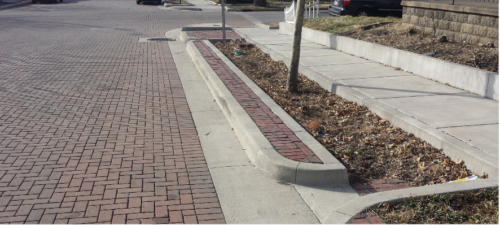 Purdue University - Extension - Forestry and Natural Resources
Purdue University - Extension - Forestry and Natural Resources
Got Nature? Blog
 Urban best management practices (BMPs) and low-impact development practices are forms of green infrastructure designed to protect water quality and quantity by reducing stormwater runoff or by storing and treating stormwater before it reaches surface waters. Low-impact development practices are intended to mimic natural infiltration processes.
Urban best management practices (BMPs) and low-impact development practices are forms of green infrastructure designed to protect water quality and quantity by reducing stormwater runoff or by storing and treating stormwater before it reaches surface waters. Low-impact development practices are intended to mimic natural infiltration processes.
This publication titled Tipping Point Planner Stormwater Definitions: Urban Best Management Practices (BMPs) and Low Impact Development Practices is written by Ben Wegleitner, social science outreach associate, Daniel Walker, community planning extension specialist, Kara A Salazar, assistant program leader and extension specialist for sustainable communities, and Lydia Utley, data analyst. It discusses the benefits of several urban best management practices for protecting or improving water quality. These BMPs include: permeable pavement, rain barrels, bioretention system, grass strip (or buffer strip), grassed swale, retention ponds, wetland basin and detention basin. The following practices are used in the Long-Term Hydrologic Impact Assessment (L-THIA) model and the Tipping Point Planner. Through Tipping Point Planner, Great Lakes communities can plan sustainable futures by directly linking data to their local decision-making processes.
Resources
Tipping Point Planner Stormwater Definitions: Agricultural Best Management Practices, The Education Store, Purdue Extension resource center
Improving Water Quality by Protecting Sinkholes on Your Property, video, The Education Store
Improving Water Quality At Your Livestock Operation, video, The Education Store
Improving Water Quality Around Your Farm, video, The Education Store
Healthy Water, Happy Home – Lesson Plan, The Education Store
Kara A Salazar, Assistant Program Leader and Extension Specialist for Sustainable Communities
Purdue University Department of Forestry and Natural Resources

Recent Posts
- From Forest to Classroom – 2024 NRTI Class
Posted: July 26, 2024 in Community Development, Forestry, Urban Forestry, Wildlife - Virtual Tour Brings Forest Management for Birds to Life
Posted: July 19, 2024 in Forestry, How To, Publication, Wildlife - Summer Tree Care – Purdue Landscape Report
Posted: July 16, 2024 in Forestry, Forests and Street Trees, How To, Plants, Urban Forestry - DNR State Deer Biologist Shares Population Ecology of Deer-IFWOA Webinar
Posted: July 12, 2024 in Forestry, Wildlife, Woodlands - Buoys Keep Eye on Great Lake Conditions
Posted: July 11, 2024 in Aquatic/Aquaculture Resources, Great Lakes, How To - ID That Tree: Learn to Identify Conifer Leaf Types
Posted: in Forestry, Forests and Street Trees, How To, Urban Forestry, Wildlife - ID That Tree: Types of Broadleaved Tree Leaves
Posted: July 10, 2024 in Forestry, Forests and Street Trees, How To, Plants, Wildlife - 2024 Turkey Brood Count Wants your Observations – MyDNR
Posted: June 28, 2024 in Alert, Community Development, Wildlife - Case Study: Maple Tree Pests – Purdue Landscape Report
Posted: June 26, 2024 in Disease, Forests and Street Trees, Plants, Spiders, Urban Forestry, Wildlife, Woodlands - Woodland Management Moment: Oak Regeneration – Protecting Seedlings
Posted: June 24, 2024 in Forestry, Urban Forestry, Wildlife, Woodland Management Moment, Woodlands
Archives
Categories
- Alert
- Aquaculture/Fish
- Aquatic/Aquaculture Resources
- Ask the Expert
- Christmas Trees
- Community Development
- Disease
- Drought
- Forestry
- Forests and Street Trees
- Gardening
- Got Nature for Kids
- Great Lakes
- How To
- Invasive Animal Species
- Invasive Insects
- Invasive Plant Species
- Land Use
- Natural Resource Planning
- Nature of Teaching
- Plants
- Podcasts
- Ponds
- Publication
- Safety
- Spiders
- Timber Marketing
- Uncategorized
- Urban Forestry
- Webinar
- Wildlife
- Wood Products/Manufacturing
- Woodland Management Moment
- Woodlands